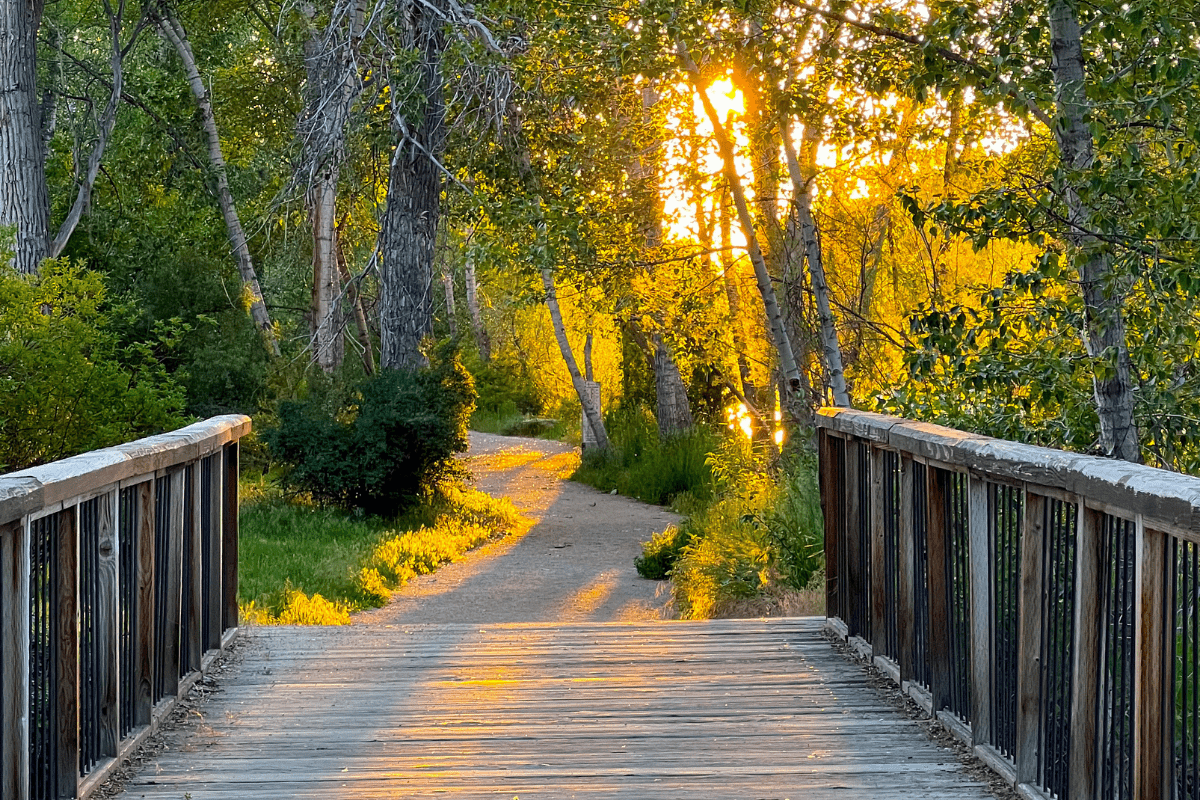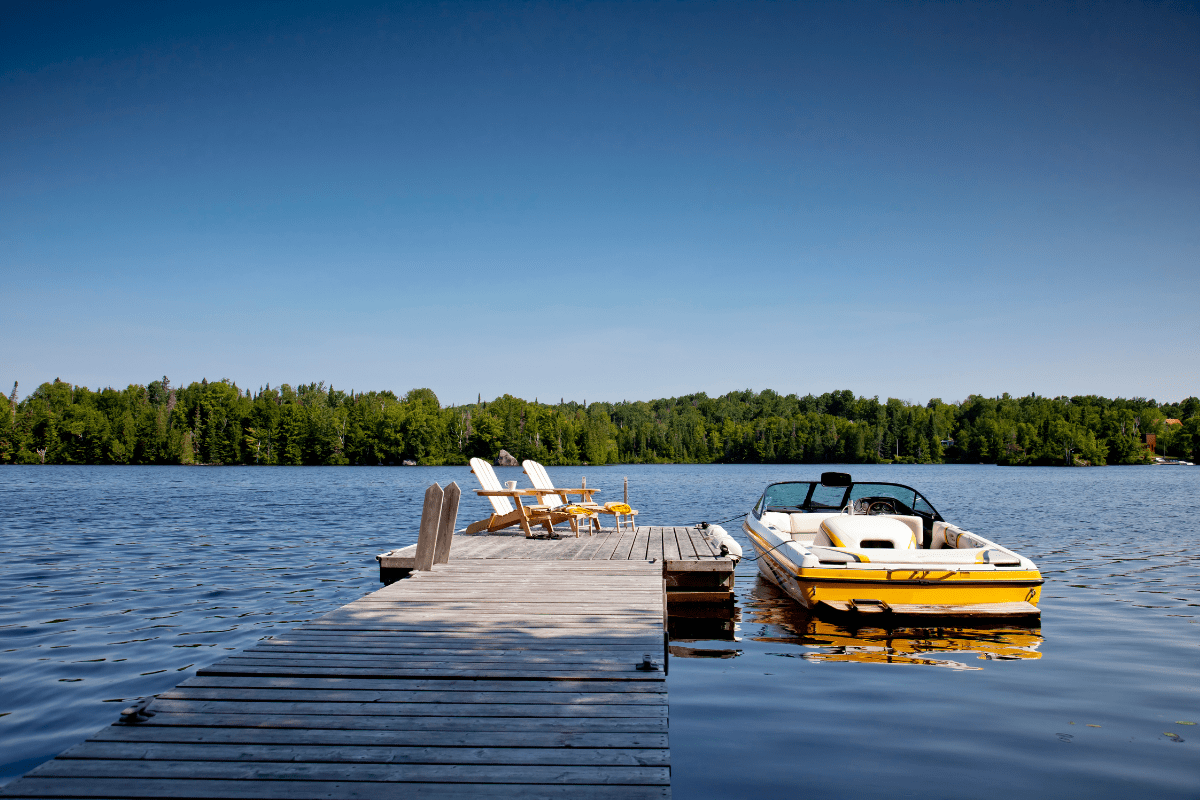Idaho harbors America's last true hidden gems… remote hot springs cascading into turquoise pools, ghost towns frozen in time, and wilderness areas larger than entire states where visitors might not see another soul for days. While tourists flock to Sun Valley and downtown Boise, the real Idaho waits in places like Atlanta, a living ghost town accessible only by rough forest roads, and Priest Lake, where 80 miles of pristine shoreline remain protected from development.
Wallace proves entire towns can be national treasures
Deep in Idaho's panhandle, Wallace stands as the only entire town in America listed on the National Register of Historic Places. This former silver mining boomtown of just 780 residents boldly declared itself the "Center of the Universe" in 2004, complete with a manhole cover marking the exact spot.
The town's underground silver mine tours, led by retired miners who worked these tunnels for decades, offer one of America's most authentic mining experiences. These aren't your typical tourist trap guides reading from scripts… these are guys named Earl and Chuck who'll tell you about the time someone accidentally blew up the wrong tunnel or how they used to smuggle beer down in their lunch pails.
The Route of the Hiawatha, a 15-mile rail-to-trail adventure through 10 train tunnels and across 7 sky-high trestles, ranks among the nation's most scenic bike rides. Pro tip: bring a headlamp because the 1.7-mile St. Paul Pass Tunnel gets darker than your soul after watching your 401k statements. Summer brings the Wallace Huckleberry Festival (August 15-17, 2025 marks its 40th anniversary), where locals compete to see who can eat the most huckleberry pie without turning purple.
February's Extreme Ski Jor event features costumed competitors being pulled on skis behind horses through downtown streets for cash prizes. Yes, you read that correctly. People dress as dinosaurs and superheroes while horses drag them through Wallace at terrifying speeds. It's exactly as chaotic as it sounds.
Getting there and staying put
Located just 45 miles east of Coeur d'Alene on I-90, Wallace makes an ideal base for exploring the historic mining district. The Brooks Hotel offers luxury accommodations in the restored Madam's Suite (yes, that kind of madam), while the Wallace Inn hosts community events in its historic building.
The Pulaski Tunnel Trail leads hikers 3.5 miles to where "Big Ed" Pulaski saved 39 firefighters during the catastrophic 1910 "Big Burn" fire by sheltering them in a mine tunnel. He literally held them at gunpoint when they tried to leave the smoky tunnel, which sounds extreme until you realize the alternative was becoming human barbecue.
Book guided historic home tours early during the Fall for History festival… they sell out quickly as visitors explore preserved Victorian homes rarely open to the public. The current owners will actually let you poke around their attics and basements, which is either incredibly generous or slightly concerning depending on your perspective.
Atlanta's living ghost town harbors natural hot springs
One of Idaho's most remote inhabited places, Atlanta sits at 5,383 feet elevation in the Boise National Forest, accessible only by rough forest roads that require high-clearance 4WD vehicles. And when I say rough, I mean your fillings might come loose.
This living ghost town, founded during the 1864 gold rush, maintains a year-round population of hardy souls who chose isolation over convenience. Ten buildings in its historic district appear on the National Register of Historic Places, but Atlanta's real treasures bubble up from the earth.
The hot springs collection nobody talks about
Multiple natural hot springs dot the area, including Atlanta Hot Springs, Power Plant Recreation Area Hot Springs, and Chattanooga Hot Springs. The latter features a dramatic 100-foot geothermal waterfall cascading down a cliff face into volunteer-built soaking pools.
Let me paint you a picture: you've just driven 80 miles on roads that would make a mountain goat nervous, your car sounds like it's auditioning for a death metal band, and then you stumble upon this steaming waterfall in the middle of nowhere. It's like finding a spa at the end of the world.
Summer visitors navigate those aforementioned 80 miles of rough mountain roads from Boise, while winter access requires snowmobiles on the only route that remains open. The 1933 CCC-built Atlanta Guard Station cabin rents for $45 per night through Recreation.gov, offering rustic accommodations for four. "Rustic" here means "hope you like outhouses."
The recently opened Beaver Lodge provides five rental cabins with the town's only restaurant and bar. And when I say "only," I mean if you don't like what they're serving, your other option is a three-hour drive back to civilization.
Planning your Atlanta adventure
With no cell service, no gas station, and only one small general store, Atlanta forces visitors to disconnect completely. Your Instagram stories will have to wait, assuming you survive the drive back to tell them.
Essential Atlanta tips:
- Bring extra gas (seriously, EXTRA gas)
- Download offline maps before leaving
- Pack food for multiple days
- Tell someone where you're going
- Bring a real camera, not just phones
- Check road conditions with locals first
- Consider tire repair kit essential
- Accept that your car will never be clean again
Plan to spend multiple days to justify the difficult journey… combine hot springs soaking with historic exploration and fishing along the Middle Fork Boise River. The fish here haven't seen enough lures to be suspicious yet.
Priest Lake preserves pristine wilderness just miles from Canada
Known as "Idaho's Crown Jewel," Priest Lake stretches 19 miles long and plunges 300 feet deep beneath the Selkirk Mountains, just 15 miles from the Canadian border. State forest protection has prevented the overdevelopment that plagues other Western lakes, preserving 80 miles of shoreline and maintaining the area's wilderness character.
Upper Priest Lake, accessible only by boat, foot, or mountain bike via a 2.5-mile thoroughfare, offers complete solitude in an alpine setting. This is where you go when regular Priest Lake feels too crowded with its dozen other visitors.
Island hopping and monster fish
Seven small islands dot the lake, including Kalispell and Bartoo Islands with Forest Service campgrounds accessible only by boat. Trophy Mackinaw (lake trout) grow to record sizes here… the state record 57.5-pound fish came from these waters. That's not a fish, that's a freshwater submarine with fins.
Granite Falls, ranked as North Idaho's top waterfall, rewards hikers with spectacular cascades easily accessible from the main road. The surrounding Selkirk Mountains hide 176 alpine lakes perfect for backcountry camping and fishing, with Hunt Lake being one of the most pristine. Most people never venture beyond the main lake, which means more solitude for those who do.
Located 62 miles northwest of Sandpoint, Priest Lake offers accommodations ranging from Elkins Resort's 30 cedar cabins to Priest Lake State Park's 150+ campsites. Summer temperatures average 74-82°F, perfect for swimming and boating, while early mornings and late afternoons provide the calmest water conditions.
Some areas lack cell service entirely… prepare for true disconnection from the digital world. Your boss can't reach you if the satellites can't find you, which might be the best vacation perk of all.
Central Idaho's dark skies reveal the universe
America's first Gold-Tier International Dark Sky Reserve spans 1,416 square miles across Central Idaho, encompassing Stanley, the Sawtooth National Recreation Area, and surrounding wilderness.
The Milky Way blazes across the night sky with such intensity that it casts shadows, visible to the naked eye year-round in this pristine darkness. Stanley, despite its popularity as a gateway town, transforms after dark into one of the planet's premier stargazing destinations. Light pollution here is so minimal that city folks often think something's wrong with the sky… turns out that's just what stars actually look like.
Beyond the typical tourist traps
Beyond the typical Redfish Lake experience, Stanley offers hidden treasures like Sunbeam Hot Springs, where natural pools bubble along the Salmon River between mileposts 201-202. Mountain Village Resort houses private hot springs in a rustic barn setting, while the spectacular Kirkham Hot Springs creates hot waterfall cascades an hour's drive away.
The historic Custer Motorway Adventure Road winds 40 miles past ghost towns and mining ruins, including the restored Yankee Fork Gold Dredge. This massive machine once ate entire hillsides looking for gold, and now it sits like a beached mechanical whale in the middle of nowhere.
Visit during new moon phases for optimal stargazing, bringing red flashlights to preserve night vision. The best viewing locations stretch along Highway 75 between Redfish and Pettit Lakes, where pullouts offer safe parking away from traffic.
Winter stargazing essentials:
- Subzero sleeping bags
- Hand warmers (lots of them)
- Thermos with hot beverages
- Emergency blankets
- Downloaded star maps
- Backup batteries (cold kills them)
Multiple outfitters including Sawtooth Adventure Company provide guided experiences, while winter visitors can explore Park Creek Ski Trails and Alturas Lake Ski Area's 10 miles of groomed trails each.
Eastern Idaho's geological wonders surprise at every turn
Soda Springs earned fame as the "Oregon Trail Oasis" for its hundreds of natural carbonated springs that refreshed pioneers.
Today, the world's only captive geyser erupts here every hour on the hour, shooting 100 feet high from a bore hole accidentally created in 1937 when drilling for a swimming pool. Talk about a happy accident… they wanted a pool and got a tourist attraction instead.
Nature's soda fountain and beyond
Hooper Springs Park lets visitors sample naturally carbonated water straight from the source… the same refreshment pioneers enjoyed 160 years ago. It tastes like unflavored seltzer that's been filtered through the earth for a thousand years, which is exactly what it is. Kids either love it or make faces like you've poisoned them.
Hidden throughout southern Idaho, extraordinary geological features await discovery. Box Canyon Springs near Wendell produces 118,000 gallons per minute from America's 11th largest spring, creating pristine turquoise pools perfect for swimming. The water stays a constant 68°F year-round, which sounds warm until you jump in.
Blue Heart Springs near Hagerman forms a heart-shaped pool of Caribbean-blue water contrasted against black basalt canyon walls, accessible only by kayaking four hours round-trip on the Snake River. Yes, you have to work for this one, but the Instagram photos alone are worth the paddle blisters.
Mammoth Cave near Shoshone opens the world's largest volcanic cave to public exploration, maintaining a constant 41°F temperature year-round with silver microorganisms creating otherworldly wall patterns. It's like nature's version of a disco ball, if disco balls were made of living slime.
These natural wonders remain genuinely undiscovered, with most tourists passing through en route to Yellowstone. Located 100 miles north of Salt Lake City via I-84, Soda Springs makes an ideal stopping point. The preserved locomotive "Half Pint" displayed in the city park spent 52 years underwater in Alexander Reservoir before its remarkable restoration. If a train can survive half a century underwater, your rental car can handle a few dirt roads.
Hidden hot springs demand effort but reward with solitude
Idaho claims more soakable hot springs than any other state… over 130 documented sites… yet many remain hidden from casual tourists.
Skillern Hot Springs requires a 6-mile round-trip hike through Sawtooth National Forest, where volunteer-built pools often sit empty, waiting for visitors willing to make the effort. The trail splits after two miles, offering a choice between the exposed high route or the shaded low trail that crosses the river at knee depth multiple times. Choose wisely: sunburn or wet boots.
Rocky Canyon Hot Springs near Crouch presents an even greater challenge… visitors must ford the Middle Fork Payette River to reach cascading pools built into the hillside. The crossing, safe only during late summer's low water, requires careful timing and sturdy water shoes. I've seen people try it in flip-flops. I've also seen those same flip-flops floating downstream without their owners.
The ultimate hot springs challenge
Chattanooga Hot Springs combines remoteness with spectacle, featuring a 100-foot geothermal waterfall feeding a large pool at the cliff base. The journey requires a high-clearance 4WD vehicle and 56 miles of rough forest roads from Lowman. Located near the living ghost town of Atlanta, this spring sees few visitors despite its dramatic setting.
Hot springs etiquette for newbies:
- Never use soap or shampoo
- Don't bring glass containers
- Pack out everything you brought
- Respect nude bathing customs
- Keep voices down after dark
- Don't monopolize the best spots
- Leave pools cleaner than found
- Share the space gracefully
Remember that responsible soaking means leaving no trace… pack out all trash, use no soap, and respect the fragile ecosystems surrounding these natural treasures. The volunteers who maintain these pools do it for love, not money, so don't be the jerk who ruins it for everyone.
Small towns preserve authentic Western character
The tiny community of Yellow Pine, home to just 32 residents, serves as the trade center for a vast wilderness basin at the intersection of Payette and Boise National Forests.
The famous Yellow Pine Music & Harmonica Festival transforms this remote outpost the first weekend of August, when 2,000-3,000 visitors descend for the quirky celebration. That's literally 100 times the normal population, which the locals handle with surprising grace and only minimal grumbling.
The rest of the year, Yellow Pine offers gateway access to Thunder Mountain Trail leading to Roosevelt Lake, where the submerged ghost town of Roosevelt lurks beneath the waters. On calm days, you can supposedly see the old buildings through the water, though this might just be something locals tell tourists after they've had a few beers.
Napoleon Dynamite country and beyond
Preston, near the Utah border, gained unexpected fame as the filming location for "Napoleon Dynamite," but the town embraces its cult status without becoming a tourist trap. Visitors can respectfully view Napoleon's house from the road, bowl at Pop'n Pin Lanes where key scenes were filmed, and shop at the same Deseret Industries thrift shop that provided the movie's iconic costumes.
The surrounding potato farms and hay fields remain authentically agricultural, offering the genuine small-town Idaho experience portrayed in the film. Locals have gotten used to tourists asking about tater tots and llamas, though they still roll their eyes a bit.
In southeastern Idaho, the hamlet of Dubois distinguishes itself as a ranching community where the annual rodeo brings together the entire region for barrel racing, bull riding, and a street dance on Main Street. Nearby Spencer claims fame as Idaho's opal capital, where visitors can tour working mines and try their luck digging for precious stones. Fair warning: opal fever is real, and you might find yourself covered in dirt, convinced the next scoop will make you rich.
Adventure beyond the obvious awaits
Idaho's hidden gems extend far beyond individual destinations to encompass entire adventure routes unknown to most travelers.
The Idaho Backcountry Discovery Route traces 1,250 miles from the Nevada border to Canada, passing through remote mountain towns accessible only by dual-sport motorcycles or high-clearance 4WD vehicles. This epic journey includes the historic Magruder Corridor and Lolo Motorway, crossing paths with fewer than 100 adventurers annually despite being one of America's premier overland routes.
City of Rocks National Reserve protects 6.2 miles of the California Trail, where quarter-million emigrants passed between 1843-1869 en route to goldfields. Axle-grease signatures remain visible on Register Rock, Camp Rock, and Treasure Rock… authentic messages from pioneers that survived over 150 years. These aren't replicas or recreations; these are actual notes from people who probably died of dysentery two weeks later.
The Frank Church-River of No Return Wilderness encompasses 2.37 million acres… larger than Delaware and Rhode Island combined… with 296 maintained trails totaling 2,616 miles. Yet 1.5 million acres remain completely trail-free, offering true wilderness exploration for those willing to venture beyond established routes. Hidden destinations like Sheepeater Hot Springs and Loon Creek Falls reward backcountry travelers with pristine natural features seen by only a handful of visitors annually.
Planning your hidden Idaho adventure
These authentic destinations require more planning than typical tourist spots but reward visitors with genuine experiences increasingly rare in the modern world.
Summer (July-September) opens access to most mountain areas, though late season offers fewer crowds and stable weather. Many forest roads close from October through May, making winter visits possible only to lower-elevation destinations or via snowmobile. Check conditions with local ranger stations, not Google… algorithms don't know about last week's washout.
Essential preparations include high-clearance vehicles for rough roads, extra fuel for remote areas, and offline maps since cell service disappears quickly outside towns. Stock up on supplies in larger communities… many small towns lack gas stations or have limited services. That "last gas for 100 miles" sign? They're not kidding.
Respect these fragile places by following Leave No Trace principles, packing out all trash, and treating locals and landscapes with care. These aren't theme parks; they're communities and ecosystems that exist whether tourists show up or not.
Idaho's hidden gems offer something beyond Instagram moments or bucket list checkmarks. They provide genuine connection with untamed nature, authentic small-town culture, and landscapes unmarred by development. In an increasingly connected and crowded world, these secret places preserve the American West as it once was… wild, welcoming, and wonderfully undiscovered. Even if your car doesn't survive the journey, your soul definitely will.





